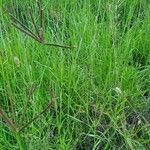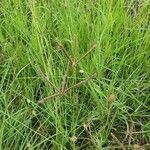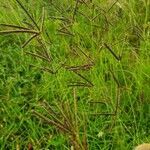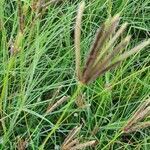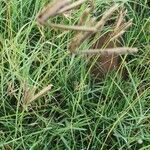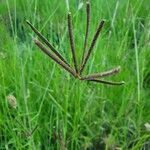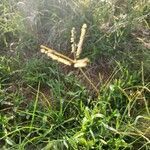Tufted perennial, 200-950 mm high, erect or geniculately ascending; rhizomatous; basal sheath strongly compressed. Leaf blade 20-180 x 2-5 mm; ligule a fringe of hairs. Inflorescence digitate, of 2-many, secund, spike-like racemes; spikelets solitary, sessile, densely packed in 2 rows on rachis. Spikelets 1.5-2.5 mm long, laterally compressed, golden-brown to dark brown; glumes unequal, 1-nerved; lower glume broad, ovate, boatshaped; upper glume oblong-elliptic, awn 0.5-1.5 mm long. Florets 2 or 3; lower floret bisexual, lemma 1.5-2.4 mm long, keeled, long-hairy on margins and nerves, shortly 2-lobed, with or without a mucro up to 1 mm long or awn up to 0.8 mm long; upper floret sterile; anther 1.0-1.5 mm long. Flowering time Oct.-May.
Perennial; up to 0.95 m high; rhizomatous and tufted. Culms erect or geniculately ascending. Leaf blades 20-180 x 2-5 mm; leaf sheaths strongly compressed; blades folded; with blunt apices. Flowers: inflorescence digitate with 4-7 racemes; (3-)4-10(-15); 50-150 mm long; spikelets 1.5-2.5 mm long; golden-brown; lower glume ovate; boat-shaped; upper glume oblong-elliptic with awn 0.5-1.5 mm long; lemmas 1.5-2.4 mm long; with or without a mucro up to 1 mm long.
Tufted perennial 200-950 mm high, erect or geniculately ascending; rhizomatous; basal sheath strongly compressed. Leaf blade 20-180 x 2-5 mm, folded, apex blunt. Inflorescence (3-)4-10(-15) x 50-150 mm. Spikelet 1.5-2.5 mm long, golden-brown to dark brown; lower glume broad, ovate, boat-shaped; upper glume oblong-elliptic, awn 0.5-1.5 mm long; lemma 1.5-2.4 mm long, with or without a awn up to 1 mm long; anthers 1.0-1.5 mm long.
Spikelets 2.4–2.5 mm long; inferior glume 1.6–2 mm long, ovate, boat-shaped; superior glume 1.8–2.4 mm long, oblong-elliptic, the awn 0.8–1 mm long; fertile lemma as long as the spikelet, ovate in profile, glabrous or sparsely pubescent on the body, ciliate on the keel and lateral nerves, emarginate, with or without an awn-point up to 0.8 mm long; sterile floret 1.2–1.5 mm long, truncate.
Perennial with thick horizontal or oblique rhizome, up to 80 cm tall, erect or ascending; leaf sheaths flabellate, in bunches at the lower nodes; leaf laminas 4.5–30 cm × 2–5(10) mm, abruptly acute.
Perennial to 1 m. Leaves linear-lanceolate, folded. Spikelets secund, in digitately arranged, spike-like branches, brown, 1.5-2.5 mm long.
Inflorescence of 5–10 digitate racemes 6–8 cm long.
